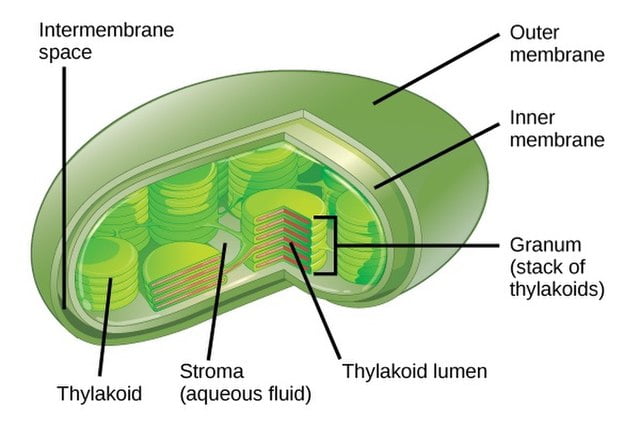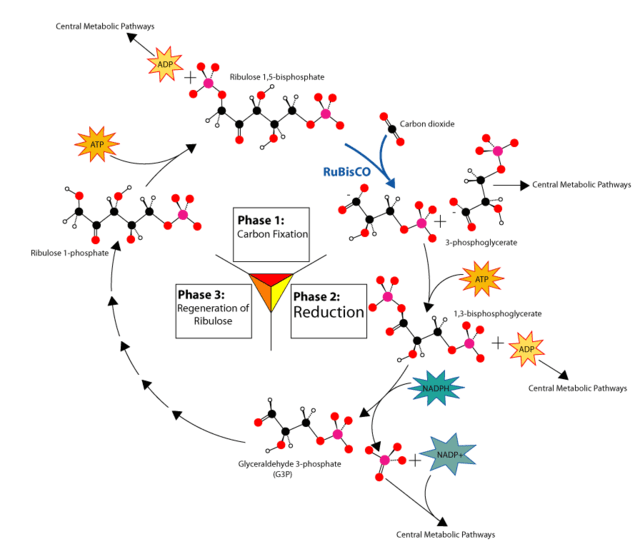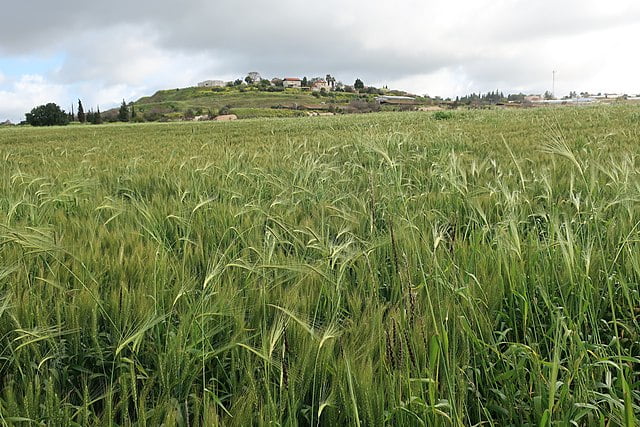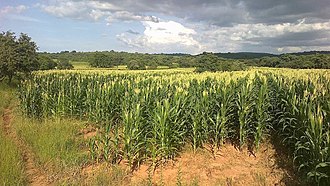Core Concepts
In this tutorial, you will learn all about photosynthesis. We begin with an introduction to photosynthesis and its balanced chemical equation. Then, we analyze the two key stages involved in this process and take a look at the final products. Lastly, we consider the different types of photosynthesis.
Topics Covered in Other Articles
- What is a Chemical Reaction? Physical vs Chemical Change Examples
- What is a Reactant in Chemistry?
- How to Balance Redox Reactions
- Common Oxidizing Agents & Reducing Agents
- What is Gluconeogenesis?
Introduction to Photosynthesis
The process by which plants and other organisms convert light energy (sunlight) into chemical energy (glucose) is known as photosynthesis. Sunlight powers a series of reactions that use water and carbon dioxide to synthesize glucose and release oxygen as a byproduct. Energy is stored in the chemical bonds of glucose and can be later harvested to fuel the organism’s activities through cellular respiration or fermentation.
Photosynthesis is an endergonic process because it requires an input of energy from the surroundings in order for a chemical change to take place. Furthermore, photosynthesis is a reduction-oxidation (redox) reaction, meaning that it involves the transfer of electrons between chemical species. During the process, carbon dioxide is reduced (i.e., gains electrons) to form glucose, and water is oxidized (i.e., loses electrons) to form molecular oxygen.
The complex process of photosynthesis takes place in chloroplasts (i.e., membrane-bound organelles in plant and algal cells). Chloroplasts have an outer membrane and an inner membrane. The stroma is the fluid-filled space within the inner membrane; it surrounds flattened sac-like structures known as thylakoids. Thylakoids consist of a thylakoid space (lumen) surrounded by a thylakoid membrane. The thylakoid membrane contains photosystems, which are large complexes of proteins and pigments. There are two types of photosystems: photosystem I (PSI) and photosystem II (PSII).

Chemical Equation for Photosynthesis
The overall balanced equation for photosynthesis is commonly written as 6 CO2 + 6 H2O → C6H12O6 + 6 O2 (shown below). In other words, six molecules of carbon dioxide and six molecules of water react in the presence of sunlight to produce one molecule of glucose (a six-carbon sugar) and six molecules of oxygen.

Stages of Photosynthesis
There are two main stages of photosynthesis: the light-dependent reactions and the Calvin cycle.
Light-Dependent Reactions
The light-dependent reactions use light energy to make ATP (an energy-carrying molecule) and NADPH (an electron carrier) for use in the Calvin cycle. In addition, oxygen is released as a result of the oxidation of water. In plants and algae, the light-dependent reactions take place in the thylakoid membrane of chloroplasts. The most common form of the light-dependent reactions is a process known as non-cyclic photophosphorylation. This process involves two key steps: ATP synthesis (via photosystem II) and NADPH synthesis (via photosystem I).
- Step 1 (ATP Synthesis): Pigments in photosystem II (such as chlorophylls) absorb light and energize electrons. A proton gradient is formed as these excited electrons travel down an electron transport chain and release energy that pumps hydrogen ions from the stroma to the thylakoid lumen. The splitting of water molecules through photolysis produces hydrogen ions (as well as oxygen molecules) that further contribute to this electrochemical gradient. As hydrogen ions flow down their gradient (i.e., back across the thylakoid membrane and into the stroma), they travel through an enzyme known as ATP synthase. ATP synthase catalyzes the formation of adenosine triphosphate (ATP) using ADP (adenosine diphosphate) and inorganic phosphate (Pi).
- Step 2 (NADPH Synthesis): Electrons are transferred to photosystem I and energized by the light absorbed by PSI pigments. The electrons reach the end of the electron transport chain and are passed to an enzyme known as ferredoxin-NADP+ reductase (FNR). FNR catalyzes the reaction by which NADP+ is reduced to NADPH.

Calvin Cycle
The Calvin cycle (also referred to as the light-independent reactions) takes place in the stroma of chloroplasts and is not directly dependent on sunlight. Instead, this stage utilizes the products of the light-dependent reactions (ATP and NADPH), along with carbon dioxide, to synthesize glucose. The Calvin cycle consists of three basic steps: carbon fixation, reduction, and regeneration.
- Step 1 (Carbon Fixation): RuBisCO (the most abundant enzyme on Earth) catalyzes the carboxylation of ribulose-1,5-biphosphate (RuBP) by carbon dioxide to produce an unstable six-carbon compound. This six-carbon compound is then readily converted into two molecules of 3-phosphoglyceric acid (3-PGA).
- Step 2 (Reduction): An enzyme known as phosphoglycerate kinase catalyzes the phosphorylation of 3-PGA by ATP to produce 1,3-biphosphoglyceric acid (1,3-BPG) and ADP. Next, another enzyme (glyceraldehyde 3-phosphate dehydrogenase) catalyzes the reduction of 1,3-BPG by NADPH to produce glyceraldehyde 3-phosphate (G3P) and NADP+.
- Step 3 (Regeneration): Every turn of the Calvin cycle produces two molecules of G3P. Therefore, six turns of the cycle produce twelve molecules of G3P. Two of these G3P molecules exit the cycle and are used to synthesize one molecule of glucose. Meanwhile, the other ten molecules of G3P remain in the cycle and are used to regenerate six RuBP molecules. The regeneration of RuBP requires ATP, but it allows the cycle to continue.

Products of Photosynthesis
The major product of photosynthesis is glucose, a simple sugar with the molecular formula C6H12O6. Plants and other photosynthetic organisms use glucose for numerous functions, including those listed below.
- Cellular Respiration: Glucose is broken down in order to produce ATP (which can be used to fuel other cellular activities) through a process known as cellular respiration.
- Biosynthesis of Starch and Cellulose: Glucose molecules can be linked together to form complex carbohydrates such as starch and cellulose. Plants and other organisms use starch to store energy and cellulose to support/rigidify their cell walls.
- Protein Synthesis: Glucose can be combined with nitrates (from the soil) to produce amino acids, which can then be used to build proteins.
In addition, oxygen is released into the atmosphere during the process of photosynthesis. Plants (along with many other organisms) use oxygen to carry out aerobic respiration.
Types of Photosynthesis
There are three main types of photosynthesis: C3, C4, and CAM (crassulacean acid metabolism). They differ in the way that they manage photorespiration, a wasteful process that occurs when the enzyme rubisco acts on oxygen instead of carbon dioxide. Photorespiration competes with the Calvin cycle and decreases the efficiency of photosynthesis (by wasting energy and using up fixed carbon).
C3 Photosynthesis
The majority of plants use C3 photosynthesis, a process in which no special features or adaptations are used to combat photorespiration. Hot, dry climates are not ideal for C3 plants (e.g., rice, wheat, and barley) because of the increased rate of photorespiration, which is due to the buildup of oxygen that occurs when plants close their stomata (leaf pores) in order to prevent water loss.

C4 Photosynthesis
C4 photosynthesis reduces photorespiration by performing the initial carbon dioxide fixation and Calvin cycle in two different cell types. This process utilizes an additional enzyme known as phosphoenolpyruvate (PEP) carboxylase. PEP carboxylase does not react with oxygen (unlike rubisco) and is able to catalyze a reaction between carbon dioxide and PEP in the mesophyll cells to produce the intermediate four-carbon compound oxaloacetate. Oxaloacetate is then reduced to malate and transported to bundle sheath cells. In these cells, malate undergoes decarboxylation, forming a special compartment for the concentration of carbon dioxide around rubisco.
As a result, the Calvin cycle can proceed as normal, and an opportunity for rubisco to bind to oxygen is prevented. C4 plants (e.g., maize and sugarcane) have a competitive advantage over C3 plants in hot, dry environments where the benefits of reduced photorespiration outweigh the additional energy costs associated with C4 photosynthesis.

CAM Photosynthesis
Crassulacean acid metabolism, also known as CAM photosynthesis, reduces photorespiration by performing the initial carbon dioxide fixation and Calvin cycle at separate times. CAM plants (e.g., cactus and pineapple) open their stomata at night, allowing carbon dioxide to enter the leaf. The carbon dioxide is converted to oxaloacetate by PEP carboxylase, the same enzyme used in C4 photosynthesis. Oxaloacetate is subsequently reduced to malate, which is stored as malic acid in vacuoles.
During the day (when light is readily available), CAM plants close their stomata and prepare for the Calvin cycle. Malate is transported into chloroplasts and broken down to release carbon dioxide, which is heavily concentrated around the enzyme rubisco. Similar to C4 photosynthesis, crassulacean acid metabolism is an energetically expensive process. However, it is quite useful for plants in hot, arid climates that need to minimize photorespiration and conserve water.


